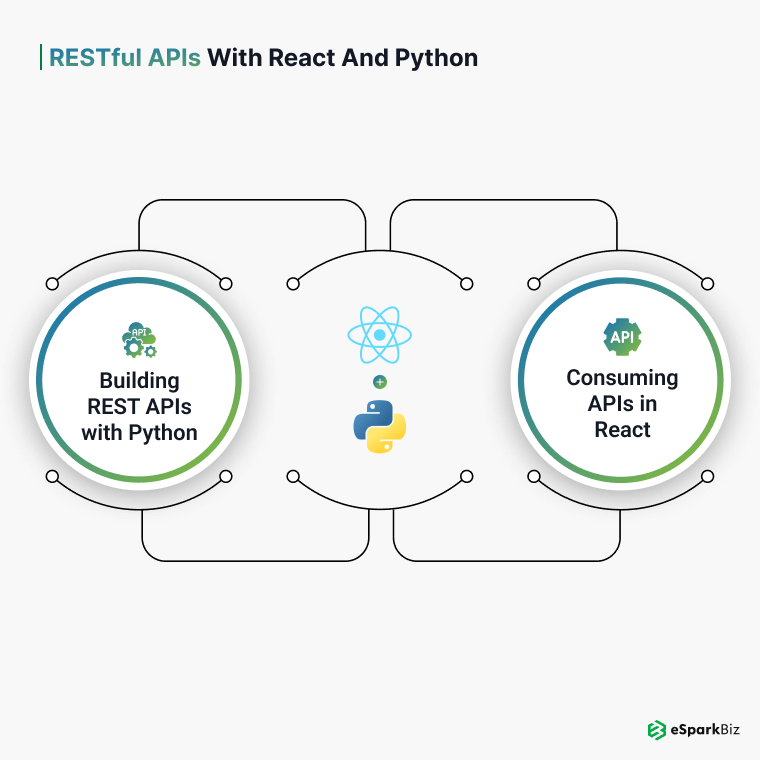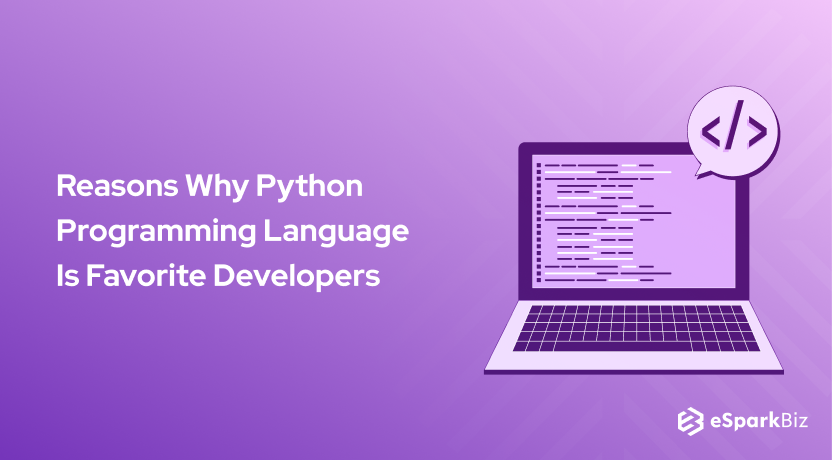Do you know that companies today use React for dynamic and lightweight frontend development to create awesome user experiences and Python on the backend for efficient request processing and simplicity? If you want to build highly scalable, ultra-responsive, and data-driven web applications, the combination of React with Python is the perfect match for your needs. This powerful duo has been adopted by major companies to deliver seamless performance and robust solutions that adapt to modern web development needs.
Understanding React and Python
What is ReactJS?
ReactJS is one of the most popular frontend frameworks in 2024. Built upon the JavaScript ecosystem, this domain specific framework can help you build fantastic and highly responsive dynamic frontends for your React applications. Many companies love ReactJS because of its extensive community support and awesome features, but there’s more to it which makes it a better choice.
Virtual DOM: ReactJS comes with Virtual DOM functionality, which compares and renders only newer parts of the DOM; this makes React built applications much faster and provides better optimization, too.
Lightweight Library: It is a lightweight library, and you can easily build and deploy your React application on all types of servers without worrying about the builds crashing due to resource constraints.
Example: Facebook was the inventor of ReactJS, and it later open sourced it to the community. Even today, engineers from Facebook maintain the React libraries. Moreover, they also used React to power their high-performance, interactive front-end.
Fact/Stat:
- React is used by more than 10 million websites globally, including high-traffic websites like Netflix and WhatsApp.
What is Python?
Python is an easy-to-learn and use general-purpose programming language that is famous for its usage across different tech domains. By leveraging the technology, Python Developers can build high-performing backend APIs, Machine learning models, AI tools, and many other things. Django and Flask are the two most popular backend frameworks in this programming language.
Example: Python is at the core of Instagram’s back end, and it handles millions of requests and massive data processing efficiently.
Fact/Stat:
- Python has been the declarative programming language for the past three years, according to TIOBE Index.
100+ Cursor AI prompt templates to build full-stack apps with Python, TypeScript, React and more.
Plus, you can use templates for it to function as an API, LLM and Agents expert. pic.twitter.com/cbhr0HaTLB
— Unwind AI (@_unwind_ai) November 4, 2024
Why Combine React with Python?
Seamless Front-End and Back-End Integration
When you use Python and React JS for your full-stack development needs, you can get a seamless integration between your frontend and backend, as both Python and React can work well with each other. Moreover, the Python backends can share data in JSON file format which is pretty easy for the React apps to consume and render.
Example: For better speed and responsiveness across a variety of devices, Netflix relies on React for its front-end user interface. The content streaming services are written in Python for seamless performance and scale.
Fact/Stat:
- Combining React and Python can reduce web development time by 40% due to the separation of concerns, improving overall performance.
Full-Stack Web Development
By combining these two technologies together, you also enable full-stack web development for your teams. The apps made with this combination will have a backend server that processes requests and stores data in the database and a dynamic frontend that can request data from the DB and re-render the page with new data.
Real-Life Example: Quora, a community-driven questioning platform, uses both Python and React JS to provide a seamless and personalized user experience across millions of users around the globe.
Setting Up React with Python
Initial Setup: Node.js and Python development Environment
Step 1: Install NodeJS
Head over to the NodeJS website, download, and install the latest stable version of NodeJS for your OS.
Step 2: Install Python
Visit the Python website, search for the latest Python version for your OS, download it, and run the installer setup.
Step 3: Verify Installations
Once the installations are complete, verify them by using the node -v command for NodeJS and python –version command for python.
Step 4: Package Manager and Virtual Environment
After verifying installations, it is time to select the best NodeJS package manager for your app. You should select NPM for your React project, as it is the most popular package manager in the NodeJS ecosystem. Also, install pip and virtualenv to create a Python virtual environment for your project.
Step 5: Code Editor
End the setup by downloading a code editor that you can use to write, run, and test Python and React User interface code. The easiest option here is VS Code and PyCharm.
Backend Routing with Python and Frontend Rendering with React
Backend Routing Setup in Python
- Install Flask or Django as both are popular python web frameworks for the project.
- Then, create API endpoints that you require in the Python app. The endpoints will help you fetch and store different data.
- In your Flask app, map your new API endpoints to views using the decorator functionality.
- After writing business logic for the endpoints, you should test them before deploying them to any server.
Also Read: Using React with Django – Ultimate Guide to Building Full-Stack Applications
Frontend Rendering With React
- Create a new project using npx create-react-app <my-app>.
- Write Python code to fetch data from the Python endpoints using the Fetch API or Axios library in React.
- Handle JSON response from endpoints and show relevant data to the user on the React app.
Real-Life Example: Spotify works on a similar setup to handle millions of requests on its real-time music streaming, where the front-end React app interacts with Python’s APIs for personalized recommendations.
Data Handling Between React and Python

Fetching Data from Python with React
- Once the API endpoints are verified, you can use them on your front end easily.
- Use the JavaScript Fetch API or Axios library to send requests to API endpoints and fetch relevant data from the backend.
- Lastly, utilize the API response data and update React components.
Real-Life Example: This app fetches data from Python backend servers in real-time for millions of requests every day, and utilizes the data to render user content, images, and posts.
Fact/Stat:
- Real-time data fetching using Python and React JS UI frameworks improves app performance by 35%, enabling seamless data flow.
Managing Forms and Authentication
Keeping apps secure is important, and that is where authentication helps. You can seamlessly hire Python Developers possessing expertise to use authentication forms in your applications by following the below steps.
- Write reusable form components that can be used across the React application for fetching user input and bind the form inputs for state management that can store and track user inputs.
- Create backend API calls to handle incoming user credentials and authentication.
- Send form data to the backend upon click of a button.
- Provide a JWT from the backend for a successful authentication request. The JWT should be supplied by the front end for all subsequent requests.
Real-Life Example: Dropbox uses React for the front-end form submission and Python for back-end authentication to ensure secure login.
Also Read: Top React Trends to Watch in 2025
RESTful APIs with React and Python

Building REST APIs with Python
If you want user interaction with structured data and show it to users on your React app, you need to build REST APIs in Python. Below is a guide on doing it.
Flask/Django: Select anyone from Flask or Django as your Python backend framework. Both these frameworks come with all the tools and setup required to build REST APIs that can be consumed by any frontend web application framework.
Endpoints: Create your REST endpoints and map them to routes in the Python backend. Always ensure that you create endpoints that conform to different HTTP methods like GET, POST, PUT, DELETE, etc.
Real-Life Example: Uber uses Python’s Flask framework to create APIs, handling real-time data for ride bookings, which is rendered dynamically using React.
Consuming APIs in React
After the APIs are created, you can consume them in your React application as you would in others. You can use the Fetch API in Axios or JavaScript library to fetch the data.
Axios: Axios is a popular library for making HTTP requests in React code, allowing easy communication with Python’s APIs.
Error Handling: Implement error handling for failed API requests to ensure a smooth user experience.
Tabular Representation of Common Libraries for API Handling in React
| Library | Functionality |
| Axios | Easy-to-use HTTP client for API requests. |
| Fetch API | Built-in JavaScript method for handling APIs. |
Real-Life Example: Netflix uses Axios in React to fetch real-time content from its Python-powered backend APIs.
Optimizing Performance in React with Python
Optimizing Frontend Rendering in React
If you want the best performance optimization technique for your React apps, you should definitely do the following things.
Lazy Loading: Lazy loading is one of the common React concepts that involves loading an item only when it is required. This saves unnecessary loading of modules and burdening of apps. Moreover, it also makes your apps much faster.
Code Splitting: Split your code into smaller modules and bundle those small modules to ensure there is no unnecessary same code loaded.
Caching and Database Optimization in Python
To make the most out of your backend servers, you can do the below performance optimization in your Python app:
Caching: Use Redis or any other caching layer to store and access frequently requested data faster.
Database Optimization: Simplify and optimize database queries to reduce data fetching time. Apply filters in your queries so that you only get the requested data.
Table Data for Performance Optimization Techniques
| Optimization Technique | Benefits |
| Lazy Loading | Reduces initial load time, improving page speed. |
| Caching | Speeds up data retrieval by avoiding frequent DB hits. |
Real-Life Example: eBay uses Python caching and React’s lazy loading to deliver a fast and efficient shopping experience.
Real-World Use Cases of React with Python
Python and React JS is a Robust ReactJS Technology combination that has lots of potential and actual real-world use cases. In the upcoming parts, we will look at some of their use cases.
E-Commerce Applications
Python provides a secure backend for your eCommerce development needs, and you can pair it with React’s dynamic and personalized frontend apps to craft the perfect combination for building and scaling secure e-commerce platforms.
User Experience: React assists in building user interfaces, whereas Python takes care of the back-end transactions securely.
Inventory Management: Python is much better at handling complex database queries for different eCommerce needs.
Real-Life Example: Shopify Combines React with Python for a seamless eCommerce experience, allowing real-time product updates and faster transaction handling.
CMS Development
You can combine Python and React JS for developing content management systems (CMS). While you hire ReactJS developers, they help you leverage React as it powers the dynamic and interactive nature to build user interfaces, your Python back-end can handle operations such as data storage, content retrieval, and API management efficiently.
Content Delivery: React will help your users to immediately create or interact with web content, while Python handles back-end requests for the same.
Scalability: Python based CMS platforms enables to manage millions of users and requests without compromising performance.
Real-Life Example: WordPress uses React for its front-end UI/UX Design and Python to manage API interactions and server-side logic.
Fact/Stat:
- Combining React with Python can increase web development efficiency by 25%, reducing time to market for CMS and e-commerce platforms.
Table Data on Popular Use Cases for React with Python
| Use Case | Benefit |
| E-Commerce Applications | Real-time product updates and faster transactions |
| CMS Development | Scalable, interactive content management |
Security Best Practices for React with Python
When building apps with Python and React JS, it’s important to focus on security for both front-end and back-end applications. Let’s look at how you can add security to your apps.

CSRF Protection in Python
Cross-site request Forgery (CSRF) is one of the most common vulnerabilities in web apps, and it can be lethal, too. You can protect your Python back-end from such attacks by simply implementing CSRF tokens.
Token-Based Security: Attach a CSRF token to each request and verify it in the backend endpoints. If the CSRF token is available, then the request is authentic; otherwise, you should reject the request.
Securing React Components
Add cross-site scripting protection to your React component and secure them from vulnerabilities by:
Sanitizing User Inputs: Never consume user inputs directly; you should always sanitize them to prevent injection attacks.
Development Environment Variables: Leverage ReactJS environment variables and secure sensitive information.
Real-Life Example: PayPal uses CSRF tokens to secure its Python backend, while React components handle input sanitization for secure transactions.
Fact/Stat:
- 60% of web development vulnerabilities are caused by Cross-Site Scripting (XSS) and CSRF, which can be mitigated by proper front-end and back-end security. You can make your apps secure by 60% if you get these two things right.
Table Data on Key Security Practices for React and Python
| Security Measure | Description |
| CSRF Tokens | Protects against cross-site request forgery |
| Input Sanitization | Prevents malicious code injection in React |
| Environment Variables | Keeps sensitive data secure |
Also Read: React Best Practices – Step towards Boosting Development Performance
Testing and Debugging React with Python
Before you deploy your apps and make them open for users, it is best to test and debug them thoroughly. This will help you ensure that your React JS and Python integration work without any issues.
Unit Testing for Python APIs
Leverage unit testing tools like PyTest or UnitTest to test Python APIs before you start using them with React application. Writing better unit tests will ensure that individual parts of the backend work correctly.
Testing Endpoints: Ensure that each REST API endpoint behaves as expected by sending test requests and validating responses.
Debugging React Components
Just like the Python backend APIs, you can also unit-test React components using libraries like Jest and React Testing Library. Doing so will help you verify that the frontend development functionality works as expected.
Snapshot Testing: This type of testing helps you verify that the React component is rendering correctly every time by comparing current outputs with previous snapshots.
End-to-End Testing: Tools like Cypress can be used to test the entire function app, right from the front-end React components to back-end Python API endpoints.
Real-Life Example: Facebook uses Jest and Python’s PyTest to automate the entire unit testing process. Both these libraries ensure that the front-end and back-end Functional component work seamlessly together, and they work as expected at each final step.
Fact/Stat:
- 40% of development teams report reduced bugs in production after adopting automated testing tools like Jest and PyTest.
Table Data on Testing Tools for Python and React JS
| Tool | Purpose |
| PyTest | Unit testing for Python APIs |
| Jest | Snapshot and unit testing for the React component |
| Cypress | End-to-end testing across React and Python |
Conclusion
Combining React with Python brings the best of both worlds: React’s dynamic, interactive user interfaces and Python’s robust back-end capabilities. This combination is ideal for building scalable, flexible, and efficient applications, whether you’re developing e-commerce platforms, CMS systems, or real-time applications. With the right implementation of these technologies, businesses can ensure code quality, enjoy faster development times, improved scalability, and seamless integration.
Many industry giants, including Shopify, Instagram, and WordPress, have leveraged the power of React with Python to create high-performance, scalable applications. This pairing enhances both front-end and back-end functionality, ensuring a smoother user experience and better handling of server-side logic.
Why Hire eSparkBiz for React with Python Development?
At eSparkBiz, we specialize in delivering custom software development solutions that leverage the power of React JS and Python, tailored to meet the specific needs of our clients.
- Expert Developers: Our Developers possess core Skills in React and Python for powerful, scalable apps.
- Proven Experience: Successfully delivered 300+ projects across diverse industries.
- Full-Stack Development Solutions: End-to-end ReactJS Development services for frontend to Python backend integration.
- Flexible Models: Engagement models tailored to your project’s needs, timeline, and budget.
- 24/7 Support: Continuous support with regular updates and maintenance.
- Client-Focused: Agile Approach, Transparent, and high-quality web development focused on delivering client satisfaction.
-
What are the advantages of combining React with Python?
Combining React’s dynamic frontend development capabilities with Python’s powerful back-end provides a robust solution.
- React handles dynamic user interfaces.
- Python simplifies server-side logic and data processing.
- Together, they create scalable, efficient applications.
-
Is it difficult to integrate React with Python?
Integrating React js and Python is straightforward with the right developer tools and frameworks.
- Use Django or Flask to handle the back-end.
- React takes care of the front-end rendering.
- RESTful APIs or GraphQL can bridge the communication.
-
What are the best use cases for React and Python together?
This combination works well for web applications needing dynamic UIs and strong data processing.
- Data-driven dashboards and analytics tools.
- Real-time web applications.
- E-commerce platforms with complex back-end logic.
-
How does React improve the performance of Python-based applications?
Key React Features boost the user experience, complementing Python’s back-end performance.
- React enables smooth front-end interaction without reloading pages.
- It improves load times and overall responsiveness.
- Python handles complex back-end tasks efficiently.








